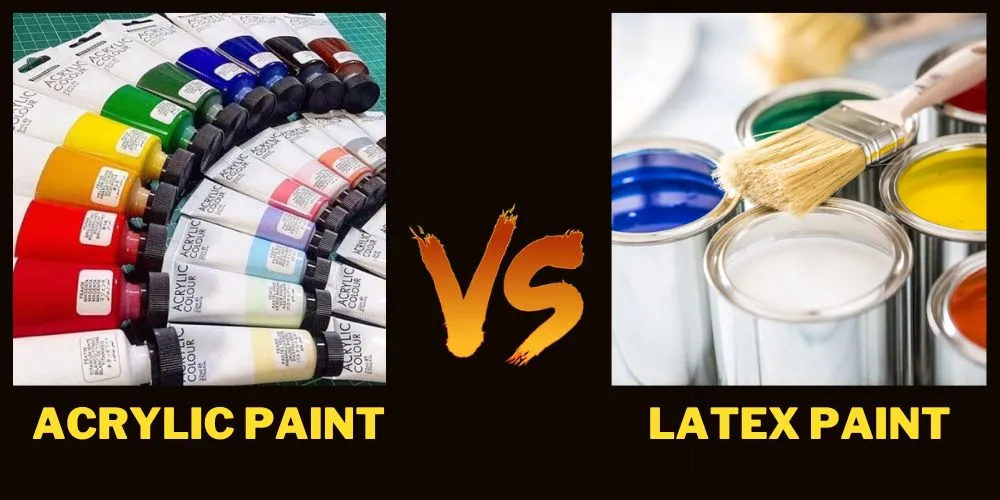Choosing the right type of paint for your painting project plays an essential role in the outcome and durability of the job.
It’s about more than just the color; the type of paint can affect everything from the application process to how the paint holds up over time.
In this guide, we cover the critical differences between acrylic vs latex Paint to help you make an informed decision.

What is Acrylic Paint?
Acrylic paint consists of pigment suspended in an acrylic polymer emulsion. It is known for its durability and resistance to the elements, making it a popular choice for artists and homeowners alike.
Acrylic paints offer excellent coverage and create a flexible layer that resists cracking.
What is Latex Paint?
Contrary to its name, latex paint does not contain any natural latex rubber but rather a water-based formula composed of a vinyl or acrylic resin.
It is the most common type of paint used in household interiors due to its ease of use and clean-up with water. Latex paints are known for their fast drying times and low odor.
Acrylic vs Latex Paint: Key Differences
The main difference lies in their formulations and the resulting endurance. Acrylic paint is chemical-based, providing higher durability suited for both interior and exterior surfaces. It stands up better in sunny areas and resists yellowing over time.
Latex paint, while excellent for indoor use, may not endure extreme weather conditions as effectively as acrylic paint. It tends to be less expensive than acrylic and is easier for everyday applications due to its water solubility.

Pros and Cons
Acrylic paint’s advantages include better color retention and stronger adhesion on various materials like wood and metal. However, it is generally pricier and may require specialized removal techniques.
On the other hand, Latex paint is easier to work with, especially for DIY decorators. It’s perfect for indoor projects. The drawback here is less resistance to environmental changes, making it less ideal for outside surfaces.
Choosing the Right Type for Your Project
When selecting paint, consider the project’s environment and the surface. Acrylic is preferable for harsh weather conditions and surfaces that experience a lot of wear and tear. Latex is suitable for indoor walls and ceilings where such resistance isn’t as crucial.
Application Tips and Techniques
For acrylic paint, ensure the surface is clean and dry before application to avoid imperfections. Using a sealing primer can enhance the durability and appearance of the finished job.
Latex paint applies best with a wet edge; be swift in your painting technique to avoid visible brush strokes.
Maintenance and Care
Maintaining acrylic-painted surfaces involves regular dusting and occasional gentle cleaning with a mild soap solution. For latex paint, wipe clean with a damp cloth. These maintenance steps help the paint look better and last longer.
Environmental Considerations and Safety
When choosing between acrylic and latex paints, environmental impact and safety are significant concerns. Below are key points to consider:

Volatile Organic Compounds (VOCs)
- Acrylic Paint: Tends to contain higher levels of VOCs than latex based on its chemical formulation.
- Latex Paint: Generally has lower VOC content, especially in versions formulated as “low-VOC” or “zero-VOC.”
- Impact: VOCs contribute to air pollution and can cause health issues such as respiratory problems, headaches, and dizziness.
Production Impact
The production process for both types of paint involves energy and resource consumption, but the specifics of the materials and processes can vary, influencing their environmental footprint.
Usage Considerations
- Acrylic Paint: More durable and resistant, suitable for high-moisture and high-wear areas, reducing the frequency of repaints.
- Latex Paint: Generally easier to apply and more forgiving in residential settings.
Disposal of Paints
- Proper disposal is crucial for minimizing environmental impact.
- Unused paint should not be poured down drains or into the environment.
- Many regions have specific paint recycling or hazardous waste handling protocols.
Recommendations for Safe Handling
- Use appropriate personal protective equipment such as gloves, masks, and eye protection.
- Ensure good ventilation when using either type of paint to minimize inhalation exposure to chemicals and VOCs.
Recycling and Reuse
- Explore options for donating unused paint to community projects, theatre groups, or recycling programs.
- Containers can often be recycled after thorough cleaning.
By considering these points, users can make environmentally safer choices and apply best practices for handling and disposal, aligning with both personal safety and ecological responsibility.
Cost Considerations
When assessing the cost implications of acrylic versus latex paint, several factors influence both immediate and long-term expenditures.
Initially, acrylic paints tend to be more expensive due to their superior durability, vibrant color retention, and resistance to environmental elements, making them a popular choice for exterior applications.
This higher quality often means fewer coats are necessary for complete coverage and longevity, potentially reducing labor costs and the amount of paint needed. On the other hand, latex paints are typically more affordable upfront and offer a practical solution for interior walls and ceilings, with a wide variety of finishes.
However, they may require more frequent touch-ups or additional layers, especially in high-traffic areas or when covering darker colors, increasing the overall cost over time.
Ultimately, the decision between acrylic and latex paint should consider the specific needs of the project, including location (interior vs. exterior), exposure to wear and weather, and desired maintenance level, to ensure a cost-effective choice that meets long-term requirements.
You may also read: Is Acrylic Paint Eco Friendly? Decoding the Eco-Friendliness
Frequently Asked Questions (FAQs)
Is acrylic paint more expensive than latex?
Yes, generally, acrylic paint tends to be pricier than latex due to its formulation and durability features.
Can I use latex paint for exterior projects?
Latex paint can be used outside, but it won’t perform as well as acrylic in extreme conditions.
How do I know if acrylic or latex paint is right for me?
Assess the project’s demands concerning weather exposure and durability. For harsh conditions and surfaces requiring tough paint, acrylic is best. For indoor projects, latex might be sufficient.
Conclusion:
Each paint type has its place in decor and construction projects. By understanding your specific needs and the inherent qualities of acrylic and latex paint, you can choose the right type for your project, ensuring durable and aesthetically pleasing results.
Choose wisely based on the surrounding environment, the project’s scope, and future maintenance possibilities.
This detailed guide aims to simplify the selection process by comparing crucial aspects of each paint type. The right knowledge leads to informed decisions, making your painting project a success.

Meet Isabella Anderson, your acrylic painting mentor with over a decade of brush-wielding mastery. Dive into the colorful world of acrylics with her expert guidance, featured exclusively on ‘Acrylic Authority.’ Unleash your inner artist and explore the limitless possibilities of this versatile medium alongside a true acrylic aficionado.
